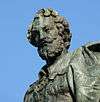Guillaume Geefs
| Guillaume Geefs | |
|---|---|
 illustration by Médard Tytgat | |
| Born |
10 September 1805 Antwerp, French Republic (modern-day Belgium) |
| Died |
19 January 1883 (aged 77) Brussels, Belgium |
| Nationality | Belgian |
| Education | Royal Academy of Fine Arts Antwerp and École des Beaux-Arts (Paris) |
| Known for | sculpture |
| Notable work | Victims of the Revolution (1838); statues, busts, and tomb monuments of statesmen and artists; Le génie du mal |
| Movement | synthesis of Late Flemish Baroque, Neoclassicism, Romanticism, Realism |
Guillaume Geefs (10 September 1805 – 19 January 1883[1]), also Willem Geefs, was a Belgian sculptor. Although known primarily for his monumental works and public portraits of statesmen and nationalist figures, he also explored mythological subject matter, often with an erotic theme.
Life
Geefs was born at Antwerp, the eldest of six brothers in a family of sculptors, the best-known of whom are Joseph Geefs (1808–1885, winner of the Prix de Rome in 1836) and Jean Geefs (1825–1860, and winner of the prize in 1846). Guillaume first studied at the Royal Academy of Fine Arts Antwerp under the late–Flemish Baroque sculptor Jan Frans van Geel and his son, Jan Lodewijk van Geel, who was also a sculptor.[2] He completed his training under Jean-Etienne Ramey at the École des Beaux-Arts in Paris and began exhibiting his work in 1828.
In 1829, Geefs traveled to Italy. When he returned to Antwerp, he began teaching at the art academy. During the 1830s, he executed the colossal work Victims of the Revolution at Brussels, as well as numerous statues and busts. In 1836, he married Isabelle Marie Françoise Corr, a Brussels-born painter of Irish descent known professionally as Fanny Geefs.[3] In the mid-19th century, the sculptor Guillaume-Joseph Charlier was an assistant to him and his brother Joseph.[4]
The Geefs family played a leading role in the craze for public sculpture that followed Belgian independence in the 1830s,[5] producing several propagandistic monuments that emphasized a "historical continuity of the southern Low Countries in the new independent state."[6]
As artist
Geefs' early work has been characterized as "predominately elegiac in mood." By the end of the 1830s, however, he developed a powerful, spare realism in monumental works such as General Belliard and Frédéric de Mérode (erected in Brussels, 1836 and 1837) and Peter Paul Rubens (Antwerp, 1841).[7] He was prolific in producing tombs, pulpits, statues, busts, and sculpture groups.[8]
Works


The works of Guillaume Geefs include:
- Frédéric de Mérode (1833/1837), tomb monument, "noted for its naturalness and lack of idealization."[9]
- General Belliard (1836), rue Royale, Brussels; more than life-size
- Victims of the Revolution (1838), an allegorical monument commemorating the Belgian Revolution
- Leopold I, considered one of the most important works of public art in Belgium in the 19th century;[10] a stamp issued in 1981 commemorates this statue; it may be viewed online
- Treurende Adonis (1839), white marble of Adonis in mourning; view online
- A small sculpture of a young sleeping angel, privately held and not authenticated (but signed by the artist), found in 1993 in an abandoned house in Brussels; see Renderosity Digital Art Community or archive
- Grétry (1842), bronze statue of the composer, in front of the opera house in Liège
- Le génie du mal, a Lucifer in white marble for the Cathedral of St. Paul, Liège
- Charlemagne (1843), statue in the Basilica of Saint Servatius in Maastricht
- The Roman Gladiator, located opposite the M. H. de Young Memorial Museum in San Francisco to mark the ground-breaking for the 1894 Mid-Winter Exposition; see online.
- Le lion amoreux or The Amorous Lion (1851), marble, Royal Museums of Fine Arts of Belgium, see online; small bronze version online.
Assessment
In his lifetime, Geefs' work was considered by some to be marred by "frivolous and inessential" details and "poverty of thought", together with a perceived frigidity of expression in his modelling. He is now regarded as the dominant Belgian sculptor of his time.[11]
| “ | He tempered academic stiffness by his flexibility; without being over-bold, he produced natural movements. Yet, he remains, like all the artists of this group, a classicist. These sculptors knew their craft; they had a taste for beautiful forms, but their art was ingenious rather than deeply felt.[12] | ” |
See also
External links
References

- ↑ ArtFact.
- ↑ "Jan Frans van Geel", Art Encyclopedia.
- ↑ "Geefs, Guillaume (1805–1883)", Philatelia.net.
- ↑ "Charlier, Guillaume(-Joseph)", ArtNet based on the Grove Dictionary of Art.
- ↑ "Sculpture et des arts décoratifs du XVIe au début du XXe siècle", LowCountriesSculpture.org.
- ↑ Léon E. Lock, LowCountriesSculpture.org. "A brief history of the sculpture in the present-day Netherlands and Belgium"
- ↑ "Geefs, Guillaume (1805–1883)", Philatelia.net .
- ↑ catalogue. Charles Flint Art & Antiques
- ↑ A brief history of the sculpture in the present-day Netherlands and Belgium
- ↑ Pierre Henrion, "La Commission des Arts de la Région wallonne," Les echos du patrimoine.
- ↑ "Geefs, Guillaume (1805–1883)", Philatelia.net.
- ↑ Max Rooses, Art in Flanders (Heinemann, 1914), p. 292 online.